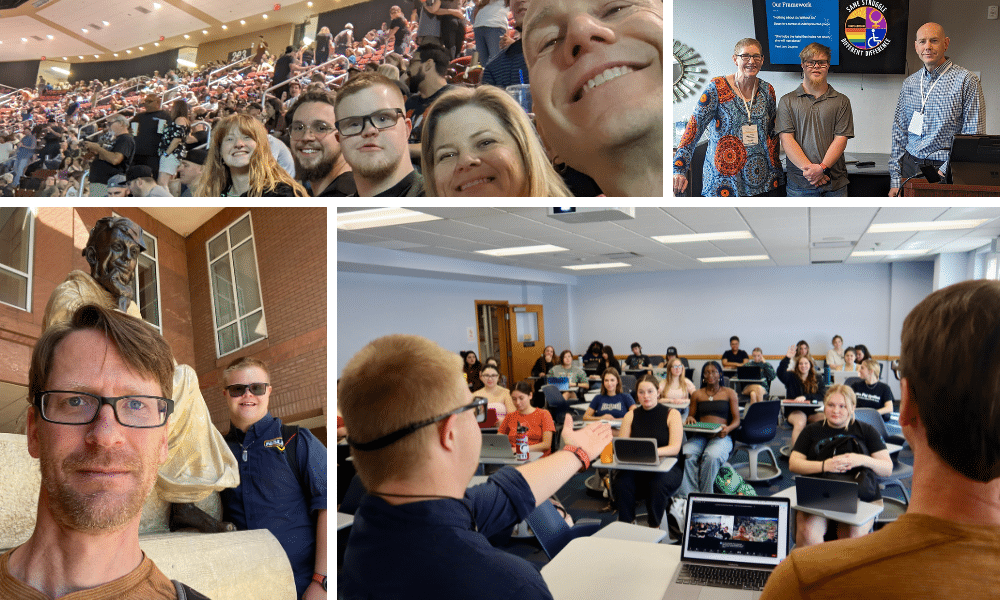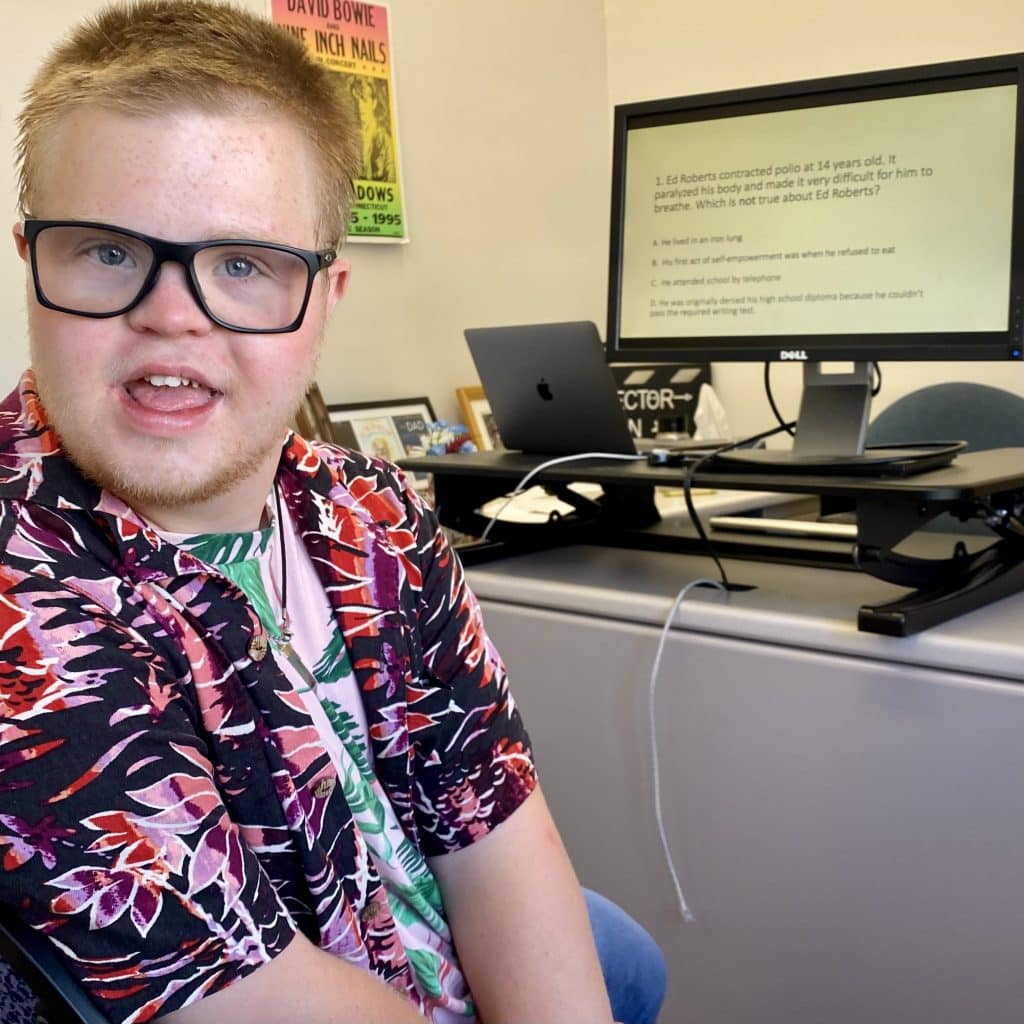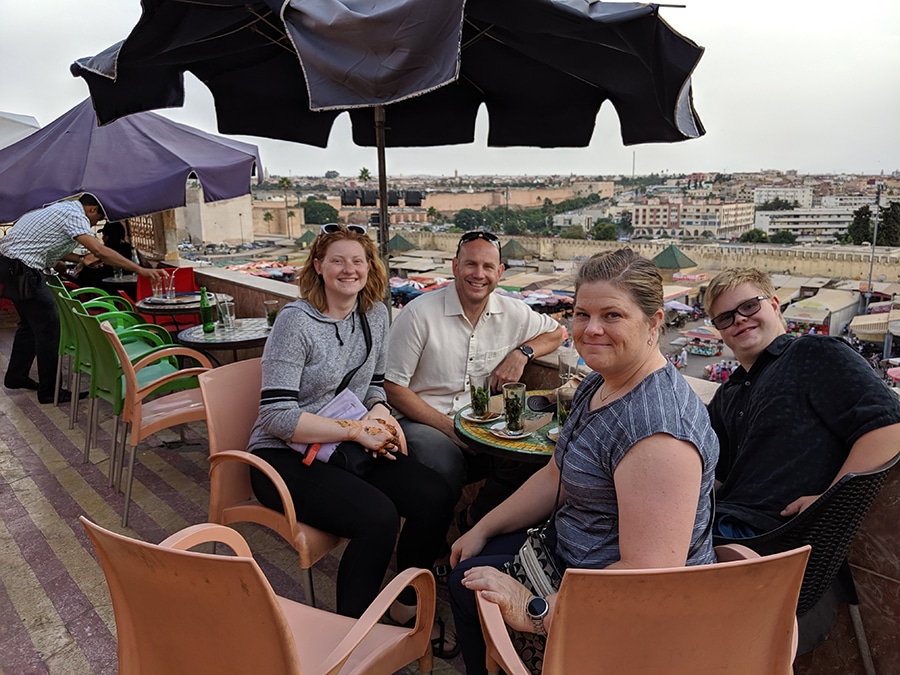On the first day of school this semester, Justice Armfield stood at the front of a DIS 201 class. At 20, he was about the same age as most of the students, but he was a guest presenter, there to share his experiences.
Armfield brings an important perspective to the disability studies class—that of a person with a disability who can describe his experience moving through a world that often isn’t built for him in mind.
“I teach people about what it is like to live with Down syndrome,” he said. “I want to help people see that a disability is a difference, but not a limitation to living a happy, healthy life with a purpose.”
 Becoming a teacher
Becoming a teacher
Armfield co-teaches Introduction to Disability Studies with John Schaffer, an academic program coordinator in NAU’s Institute for Human Development (IHD). The class covers the definitions of disability, models of disabilities, ableism, the history of the disability rights movement, disability pride and culture, media representations of disability and other related topics. The goal of the class, Schaffer said, is to recognize and challenge ableism, teach students how to be better advocates for the disabled community, or for themselves, and how to create a more inclusive and accessible world that accepts and respects people with disabilities.
Schaffer and Armfield met last year, when Armfield was on a panel discussion for the Commission on Disability Access and Design. Armfield was part of the Flagstaff Community Transition program, which provides work, training and other opportunities for people with disabilities who are done with high school but still transitioning to adulthood. Armfield was working for facilities in the College of Education.
After they met, Schaffer asked Armfield to be part of a video he was producing for IHD. From there, the collaboration grew, and Schaffer asked Armfield to co-teach the class with him. Armfield is a great resource for the students.
“They get to hear about how Justice has typical experiences for a 20-year-old—for example, he saw Pink in concert earlier this month—but also that he has very different experiences, such as going to an overnight camp with other young adults with disabilities,” Schaffer said. “They also get to see how we can include someone with Down syndrome in roles that many people don’t think are possible. That kind of representation is very powerful.”
Armfield talks through his own disability; Down syndrome means he doesn’t always think clearly, and sometimes he thinks slowly. He doesn’t have any physical disabilities, and he is working to be independent.
 In and out of the classroom
In and out of the classroom
It’s not just Pink; Armfield has been seen the Smashing Pumpkins, Jane’s Addiction, Sam Hunt and the Zac Brown Band in concert this year. He also has a YouTube channel, he likes to meditate and work out with his father, and he travels as much as he can—he’s been throughout the country as well as North Africa and Europe.
In fact, last summer he went to Paris to present with his father and aunt about his experience learning to use the bus system.
That all helped prepare him to be in the classroom teaching and interacting with the students in small groups and one-on-one. He’s enjoyed the teaching experience thus far, he said.
“I get to help people and have conversations with students who treat me kindly and respectfully,” he said. “We get to communicate and learn from each other in DIS 201.”
That’s a valuable experience for both students and teacher, Schaffer said. The students learn how to interact with a person with an intellectual or cognitive disability. Armfield interacts with his peers.
“With Justice, it’s not much different than interacting with anyone else in the class, and that by itself can help the students feel more comfortable interacting with other people with intellectual or cognitive disabilities,” Schaffer said.
How to be a good ally
This isn’t a hard task, but it does require consistent work and awareness, Schaffer said. It’s also work that everyone—not just people with disabilities or students in DIS classes—needs to actively do. He offered a few tips:
- Listen to people with disabilities. This includes listening to leaders in the disability rights movement, but also listening to your family, friends, students and co-workers who have disabilities.
- Learn to recognize ableism in its many forms, both in one’s thoughts and actions and also others. Once you start listening to the disabled voices and believing what they are saying, and become aware of the barriers and stigma around disability, you’ll have a pretty good idea of how you can be a good ally for them.
- 3. Look for opportunities to make society more accessible. For students in the program, this may mean going into professional fields that serve people with disabilities. For others, it means advocating for policies that will help those in the disability community. For everyone, it means treating the people with disabilities around them with respect and including them in their workplaces, classrooms and recreational activities.
“I tell my students all the time that they have the power to improve the lives and opportunities for people with disabilities,” Schaffer said. “It’s just a matter of doing it.”
Learn more about Disability Resources at NAU and the Institute for Human Development.
Heidi Toth | NAU Communications
(928) 523-8737 | heidi.toth@nau.edu
Join the Accessibility Expedition! On Oct. 27, the Commission on Disability Access and Design is sponsoring an exploration of NAU’s North Campus buildings and pedways and see how the campus has become more equitable and inclusive for all university community members. Pizza and drinks will be provided after the exploration.
When: 11 a.m. to 1 p.m. Friday, Oct. 27
Where: Meet at the Lumberjack statue on the north side of the Union.
Who: Everyone!




 Becoming a teacher
Becoming a teacher In and out of the classroom
In and out of the classroom